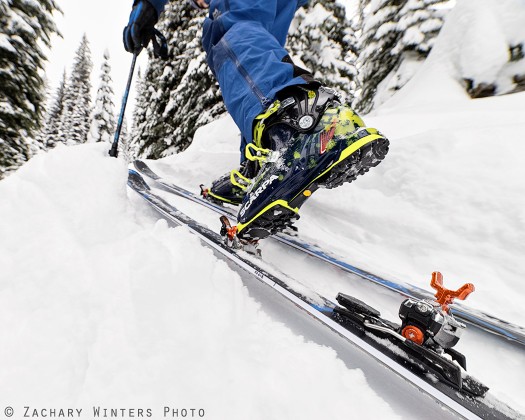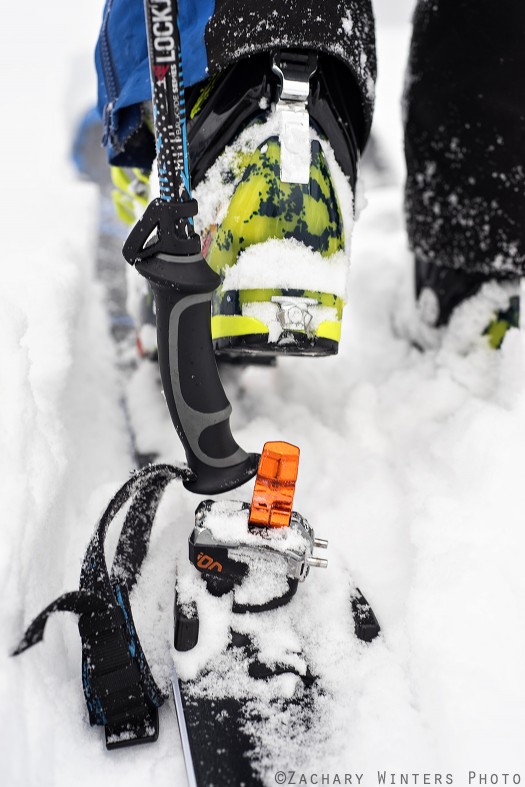(For ION technical details please see our extensive ION backcountry skiing binding first look review.)
Wildsnow’s gone fully mobile lately.The older generation is in Europe, and I’ve been in the Canadian Kootenays and Selkirks (although my trip might more accurately be described as “transient”).
While on our trip in Nelson, I was able to get a day testing out G3’s new ION touring binding (they like it spelled with all caps). Cam Shute, one of the G3 engineers, lives in the powder paradise of Nelson. Cam trusted me enough to let me throw a pair of new skis and ION bindings in the car for a day of touring in the Whitewater backcountry. Although only a one-day tryout, I attempted to abuse the new binding. Fresh powder reduced the abuse level, but I did get in a good test session.
It’s important to note that the ION bindings I tested were pre-production prototypes with small issues still being worked out. With that caveat, I did feel I was able to get a good feel for the ION. Comments on durability will have to wait until full production bindings are available.
My first impression of the bindings is that they look sexy! On a less superficial level, they feel and appear well-made, with unique new features that push the development of touring bindings.
The brake system is one of the quality parts of the ION. Brakes on tech bindings have long been a compromise resulting in a brake that is lightweight and removable, but doesn’t perform as well as a brake on a standard alpine binding. ION brakes are held down by a small catch that engages when the binding is flipped to touring mode (same as G3’s current ONYX binding). This allows two things; the brakes have a much stronger spring pressure so they work better as ski stoppers, and they are deployed until you step into the binding, in tour or alpine mode. In other words, you’re less likely to lose a ski at the top of a peak because you’ve got your brakes locked up in touring mode.
I was impressed with the brakes during my little tour. I could see it being convenient on exposed transitions to have the brakes deployed all the time. (They might also work as make-shift ski crampons on icy skin tracks, since they can be deployed in tour mode. Indeed, perhaps the future of ski brakes on touring bindings is for them to have a “crampon” mode?)
ION bindings incorporate “forward pressure” heel elasticity into the design. This is somewhat similar to most alpine bindings (although the pressure is not constant), and very similar to some of the other other newer tech offerings. With ION, one small but possibly super important difference is the forward pressure slider is “locked out” in tour mode, so that the binding heel unit can’t move fore/aft while you’re stepping on it in touring mode. This could prove to be important to make sure the mechanism doesn’t wear out, and the binding doesn’t shift while using the heel lifters.
The brake/touring heel lock out also moves the binding back slightly, so there is more room between the boot heel and the binding when you’re in heel-flat-on-ski mode. To test this I jammed through a creek that made a sharp dip in the skin track, a situation that would make many other tech bindings “bind up” from the boot heel getting caught by the heel piece. The extra space successfully mitigated this problem. (Admittedly, I only experience such situations for only one or two steps every few tours. But still, the way to improve what’s essentially a copy of an existing product is to make many small enhancements, and this is one.)
The heel lifters are similar to other fold-up-down inspired heel lifters, with advantages and disadvantages. The biggest difference is that the lifters are symmetrical — the binding can be turned both clockwise and counter clockwise to set for touring. In my view this is an advantage, making the binding both easy to use and more durable. The lifters are also not as spring loaded as Dynafit’s version, making them not “snap” into place as easily. They are still fairly easy to operate with ski poles grips. However, when changing modes without removing skis, you can’t switch modes with a ski pole tip as easily.
And yes, ION has no specific feature for switching from downhill to touring mode without exiting binding, though you can learn a technique similar to other tech bindings that allows you to pop your heel up out of the binding while at the same time rotating the heel unit. Within a few minutes I was able to figure out how to use a method similar to the one I usually use with the handle of my ski pole and leaning forward in my boots. G3’s brake system actually makes the mode change slightly easier, since the turning binding doesn’t press the brake down, like it does in other tech bindings. In our experience, on-the-fly mode changes are one of the more over rated features of some ski touring bindings. Sure, the extra 30 seconds you save by doing so is nice, but it’s not going to change the outcome of your day. So moving on…
ION has “nearly neutral” ramp/delta angle, like most alpine bindings. (WildSnow.com measures ION ramp to essentially equal that of most early tech bindings, meaning it still has ramp/delta, but not nearly as much as some of today’s excessively ramped tech bindings.) Although ramp angle is somewhat based on personal preference, I favor neutral, and people switching from alpine bindings will find it easier to get used to as well.
A few other small features are nice design details. My favorite: all adjustment and mounting screws are #3 Pozi. My repair kit suddenly got simpler. Also, the binding has a clever mechanism that raises two plastic posts in front of your boot toe to help locate your boot when you enter the binding. These “boot stops” are probably unnecessary for the experienced tech binding user, but might be quite nice for newbies. What’s cool is they fold down once you snap into the binding. (Note that the boot stops only work for DIN sole ski boots; those with trimmed toes don’t index close enough for the system to function.)
ION binding weight is not final, but similar to other tech bindings with brakes. (Our other, technical blog post about ION has specific weights.) I’d like the binding to be lighter, and it’s possible ION could be stripped down by removing the boot location feature from the toe unit, and removing the brake. On the other hand, the fully featured ION is an exciting new offering in the beefier, tech binding “freeride” segment.
Although mine was just a quick test, I was impressed. This is a welcome iteration of tech bindings, with innovative improvements that go beyond a mere copy of existing products.
ION will got to full retail in fall of 2014.
Louie Dawson earned his Bachelor Degree in Industrial Design from Western Washington University in 2014. When he’s not skiing Mount Baker or somewhere equally as snowy, he’s thinking about new products to make ski mountaineering more fun and safe.


